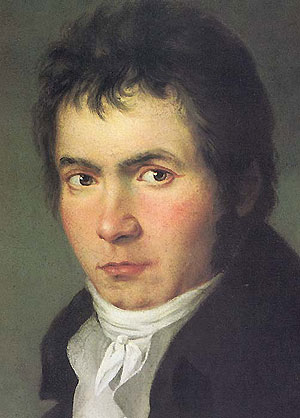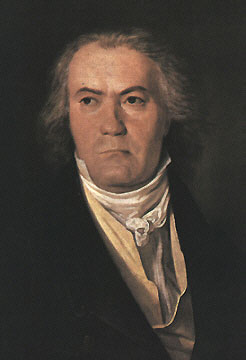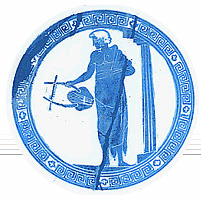|
BEETHOVEN

Ludwig
Van Beethoven
(1776-1827)
|
Ludwig
Van Beethoven personifies in music what is heroic, powerful,
sensitive, energetic and what represents victory over struggle.
When he was 5 years old America's Declaration of Independence
was signed and when he was 18, the French Revolution broke
out. Beethoven believed in the French Revolutions aspirations
toward "Liberty, Equality and Brotherhood." In addition
Beethoven had to fight the injustices of his alcoholic father
and the death of his mother when he was 15. He raised his
family by being a pianist, organist and music teacher and
thus attained a tremendous amount of responsibility at an
early age. These circumstances bred an inner strength but
also a certain amount of contempt for the outer world. Beethoven
sees himself as a survivor.
In
1790 Beethoven started to go deaf. He took the news tragically.
His diary reads, “How could I possibly mention to others
the loss of a sense which in me should be more perfectly developed
than in other people, a sense which at one time I possessed
in the greatest perfection. How humiliated I have felt when
somebody standing beside me heard the sound of a flute in
the distance and I heard nothing! Such experiences made me
despair. I would have ended my life it was only my art that
held me back.” By 1802 Beethoven recognize that he suffered
a total loss of hearing. He withdrew from society and lived
in solitude in Heiligenstadt just outside of Vienna. It was
here that he wrote some of his most beautiful pieces (the
late piano sonatas symphony 9, Ode to Joy, and his late string
quartets). His condition was a devastating one for a musician,
but he continued to compose some of his most well known and
respected works. His style at this time (the last 10 years
of his life) could be described as "other worldly, serene,
introspective and peaceful." Through composing and offering
the world magnificent music, Beethoven overcame life's pain
and sorrow and in the end can be seen as individual who rose
above his own fate.
Beethoven’s
works are often divided into three periods. These are stylistic
phases that his life and consequently his compositions go
through. They reflect turning points as well as personal experiences
in his life at the time of his musical compositions. In addition
to mapping Beethoven’s psychological progression they
also give great insight into his music.
| Beethoven’s
early period works 1792- 1802 |
 |
|
 |

Young
Beethoven
Beethoven’s
works follow the model of Mozart and Haydn. Beethoven left
Bonn at 19 to study with Haydn and was trained in a strict
classical mold but it didn’t take Beethoven long to
break the classical forms. He extended the classical forms
such as sonata form, variation form, minuet and trio and rondo
form. He changed them by altering the standard tempos and
wrote scherzo’s (scherzo means joke, as if to mock the
classical minuet) instead of minuet and trio’s.
Listen
to how much the 1st piano concerto by Beethoven
sounds like Mozart or Haydn:
| Beethoven’s
middle period works 1802-1812 |
 |
|
 |

Beethoven
in 1804
The
French revolution of 1789 had a profound effect on Beethoven.
His Third Symphony was named "Eroica" and dedicated
to the early hero of the French Revolution, Napoleon. However
the dedication was angrily withdrawn when Napoleon declared
himself emperor and proved himself not to be the leader of
freedom, democracy and the preserver of self-determination.
Beethoven stood for those democratic ideals and his music
took on a triumphant, victorious and conquering quality characterized
by driving rhythms, dynamic orchestral affects and self assured
march like qualities.
In
addition he became aware of his growing deafness and his inability
to hear loudly and with clarity.
Listen
to a strong, rhythmic and triumphant passage from the final
movement of Symphony No.5.
| Beethoven’s
late period works 1813 to 1827 |
 |
|
 |

Beethoven
in 1827
The
final period in Beethoven’s life was when he was totally
deaf. He produced works that transcend history and will be
truly immortal. They show a deep spirituality in the tender
melodies, meditative moods, passionate harmonies and in some
of his works like the 9th Symphony, the last five Piano Sonatas
and the Miss Solemnis, a sublime outpouring of emotion.
Listen
to Beehoven's personal vision of universal joy, nobility and
warmth in the Ode to Joy theme:
Listen
to a meditative, intimate and personal statement from his
3rd piano concerto:
| Beethoven's
contributions toward the future of music: |
 |
|
 |
 Beethoven fit the form of the music to match the expression
of what was being
Beethoven fit the form of the music to match the expression
of what was being
 created. His
autobiographical works of self expression and human values
are an created. His
autobiographical works of self expression and human values
are an
 example of
much of the music that will eventually follow. example of
much of the music that will eventually follow.
 The many movements of a symphony are seen as one long
narrative.
The many movements of a symphony are seen as one long
narrative.
 The linking
movements by using the same motive from one movement to the
next. The linking
movements by using the same motive from one movement to the
next.
 Using Program Music (instrumental music descriptive
of a scene, poem, story or
Using Program Music (instrumental music descriptive
of a scene, poem, story or
 some other
literary source). some other
literary source).
 Powerful rhythmic drive in opening and closing movements
of a symphony.
Powerful rhythmic drive in opening and closing movements
of a symphony.
| 






